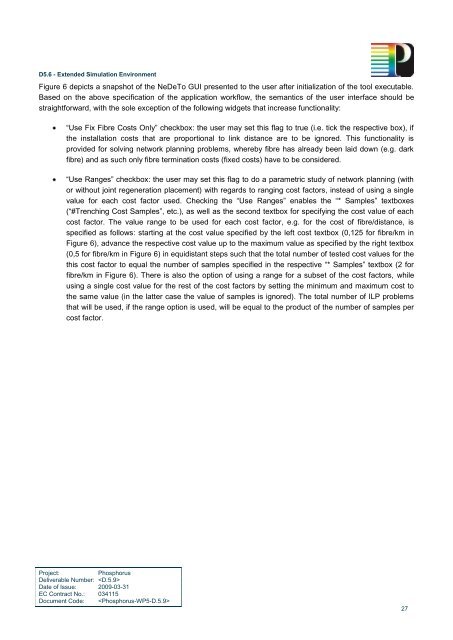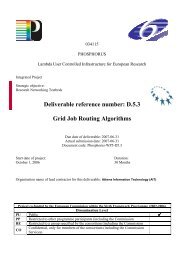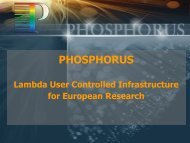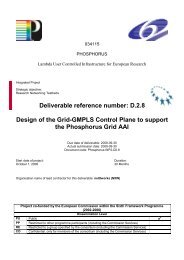D5.9: Extended Simulation Environment - Phosphorus
D5.9: Extended Simulation Environment - Phosphorus
D5.9: Extended Simulation Environment - Phosphorus
You also want an ePaper? Increase the reach of your titles
YUMPU automatically turns print PDFs into web optimized ePapers that Google loves.
D5.6 - <strong>Extended</strong> <strong>Simulation</strong> <strong>Environment</strong><br />
Figure 6 depicts a snapshot of the NeDeTo GUI presented to the user after initialization of the tool executable.<br />
Based on the above specification of the application workflow, the semantics of the user interface should be<br />
straightforward, with the sole exception of the following widgets that increase functionality:<br />
“Use Fix Fibre Costs Only” checkbox: the user may set this flag to true (i.e. tick the respective box), if<br />
the installation costs that are proportional to link distance are to be ignored. This functionality is<br />
provided for solving network planning problems, whereby fibre has already been laid down (e.g. dark<br />
fibre) and as such only fibre termination costs (fixed costs) have to be considered.<br />
“Use Ranges” checkbox: the user may set this flag to do a parametric study of network planning (with<br />
or without joint regeneration placement) with regards to ranging cost factors, instead of using a single<br />
value for each cost factor used. Checking the “Use Ranges” enables the “* Samples” textboxes<br />
(“#Trenching Cost Samples”, etc.), as well as the second textbox for specifying the cost value of each<br />
cost factor. The value range to be used for each cost factor, e.g. for the cost of fibre/distance, is<br />
specified as follows: starting at the cost value specified by the left cost textbox (0,125 for fibre/km in<br />
Figure 6), advance the respective cost value up to the maximum value as specified by the right textbox<br />
(0,5 for fibre/km in Figure 6) in equidistant steps such that the total number of tested cost values for the<br />
this cost factor to equal the number of samples specified in the respective “* Samples” textbox (2 for<br />
fibre/km in Figure 6). There is also the option of using a range for a subset of the cost factors, while<br />
using a single cost value for the rest of the cost factors by setting the minimum and maximum cost to<br />
the same value (in the latter case the value of samples is ignored). The total number of ILP problems<br />
that will be used, if the range option is used, will be equal to the product of the number of samples per<br />
cost factor.<br />
Project:<br />
<strong>Phosphorus</strong><br />
Deliverable Number: <br />
Date of Issue: 2009-03-31<br />
EC Contract No.: 034115<br />
Document Code: <br />
27






